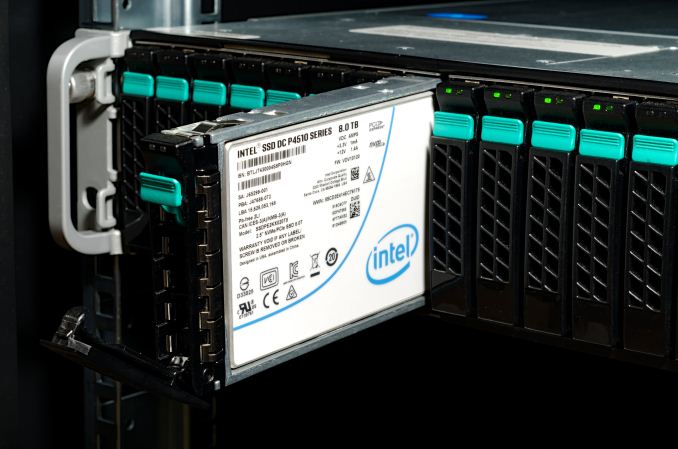The Intel SSD DC P4510 SSD Review Part 1: Virtual RAID On CPU (VROC) Scalability
by Billy Tallis on February 15, 2018 3:00 PM EST- Posted in
- SSDs
- Storage
- Intel
- RAID
- Enterprise SSDs
- NVMe
- U.2
- Purley
- Skylake-SP
- VROC
Looking Forward
So far, we've only scratched the surface of the Intel SSD DC P4510 and Intel's VROC solution for NVMe RAID. We've been able to verify only the most basic specifications for the drives, but most of the initial results match up with our expectations. The 8TB Intel SSD DC P4510 offers some substantial performance increases over the 2TB model, and the aggregate capacity and performance it enables from a single server is impressive. Once we get the necessary adapter to measure power consumption of U.2 drives with our Quarch XLC Programmable Power Module, we will begin a deeper analysis of the P4510 on a single-drive basis, comparing it against competing enterprise NVMe SSDs. It is already clear that Intel has made significant generational performance improvements, but the purported efficiency improvements will be at least as tantalizing to datacenter customers. The 16W rated power draw of the 8TB P4510 sounds pretty good in comparison to the 20.5W draw of a 4TB P4500, or the 12W of a 2TB P3520.
Intel's Virtual RAID On CPU (VROC) solution for NVMe RAID has very particular requirements for its use, but once all the pieces are in place, its use is straightforward. The experience using VROC on Linux has been fairly smooth so far, but we have not yet attempted to install an operating system to a VROC array. The RAID-0 and RAID-10 performance we've observed shows excellent scalability to 11.6GB/s sequential reads and over 2M random read IOPS from four drives, with no effort on our part to fine-tune the system for maximum performance. At the moment, we are testing RAID-5 performance and the CPU usage of the parity calculations involved in writing to RAID-5 arrays. At the speed of four NVMe drives like the P4510, this overhead is significant and requires multiple CPU cores, but it is unavoidable: there are no hardware RAID solutions for NVMe drives that can keep up with an array of four P4510s.











21 Comments
View All Comments
ABB2u - Thursday, February 15, 2018 - link
Is Intel VROC really software RAID? No question RAID is all about software. But, since this is running underneath an OS at the chip level why not call it Hardware RAID just like the RAID software running on an Avago RAID controller? In my experience, I have referred to software RAID as that implemented in the OS through LVM or Dsik Management, the filesystem like ZFS, or erasure encoding at a parallel block level. --- It is all about the difference in latency.saratoga4 - Thursday, February 15, 2018 - link
>Is Intel VROC really software RAID?Yes.
> In my experience, I have referred to software RAID as that implemented in the OS
That is what VROC is. Without the driver, you would just have independent disks.
Samus - Thursday, February 15, 2018 - link
So this is basically just storagespaces?tuxRoller - Friday, February 16, 2018 - link
Storage Space is more similar to lvm & mdadm (pooling, placement & parity policies, hot spares, and a general storage management interface) while vroc lets the os deal with nvme device bring up & then offers pooling + parity without an hba.HStewart - Thursday, February 15, 2018 - link
I would think any raid system has software to drive - it maybe on say an ARM microcontroller - but it still has some kind of software to make it work.But I would doubt if you can take Intel's driver and make it work on another SSD. It probably has specific hardware enhancements to increase it's performance.
Nime - Thursday, March 21, 2019 - link
If RAID controller uses the same CPU as OS it might be called soft. If the controller has its own processor to calculate disk data to read & write, it's a hard raid system.saratoga4 - Thursday, February 15, 2018 - link
I would be interested to see performance of normal software raid vs. VROC since for most applications I would prefer not to boot off of a high performance disk array. What, if any, benefit does it offer over more conventional software raid?JamesAnthony - Thursday, February 15, 2018 - link
I think the Raid 5 tests when you are done with them are going to be an important note in what the actual performance the platform is capable of.boeush - Thursday, February 15, 2018 - link
Maybe a stupid question, but - out of sheer curiosity - is there a limit, if any, on the number of VROC drives per array? For instance, could you use VROC to build a 10-drive RAID-5 array? (Is 4 drives the maximum - or if not, why wouldn't Intel supply more than 4 to you, for an ultimate showcase?)On a separate note - the notion of paying Intel extra $$$ just to enable functions you've already purchased (by virtue of them being embedded on the motherboard and the CPU) - I just can't get around it appearing as nothing but a giant ripoff. Doesn't seem like this would do much to build or maintain brand loyalty... And the notion of potentially paying less to enable VROC when restricted to Intel-only drives - reeks of exerting market dominance to suppress competition (i.e. sounds like an anti-trust lawsuit in the making...)
stanleyipkiss - Thursday, February 15, 2018 - link
The maximum number of drives, as stated in the article, depends solely on the number of PCI-E lanes available. These being x4 NVME drives, the lanes dry up quickly.